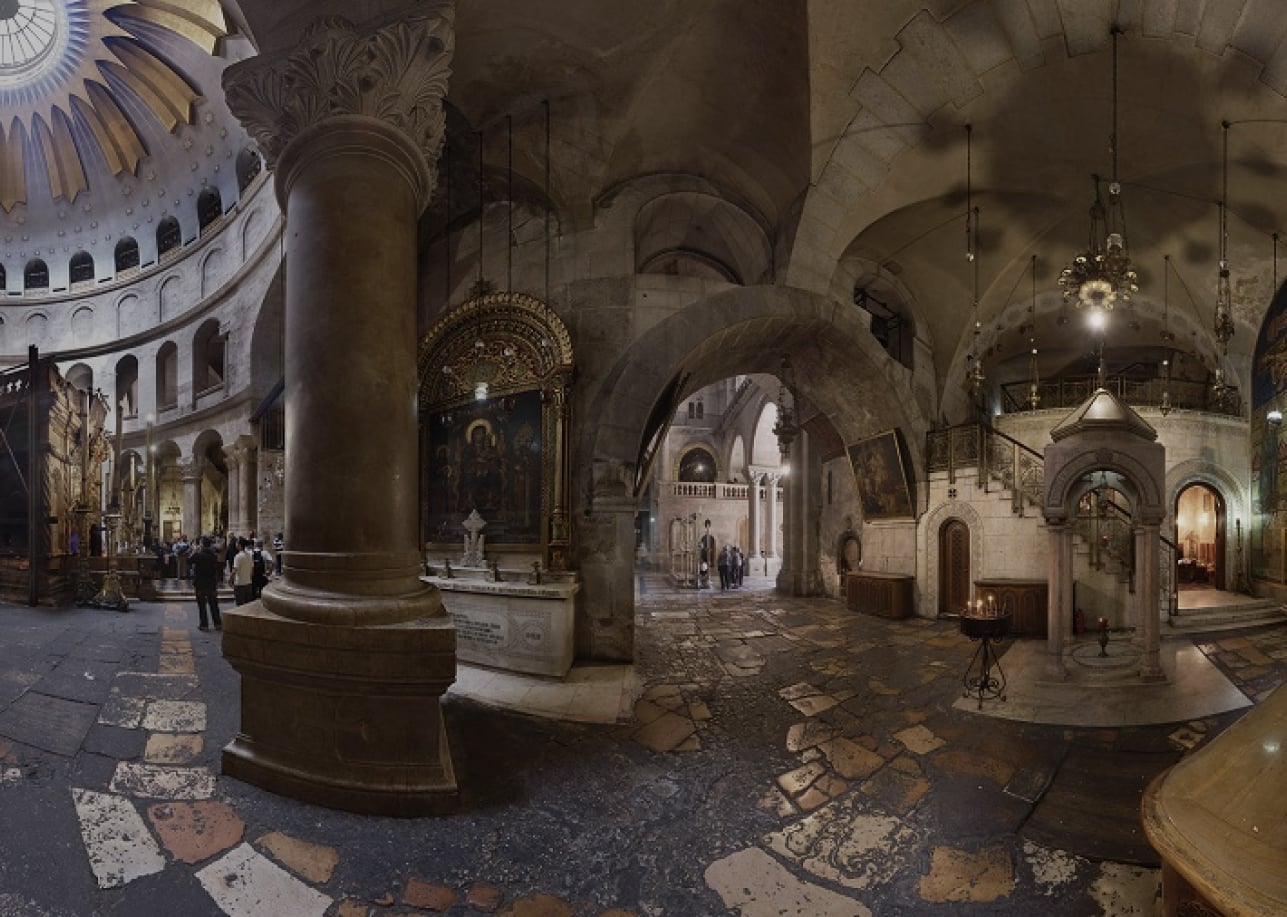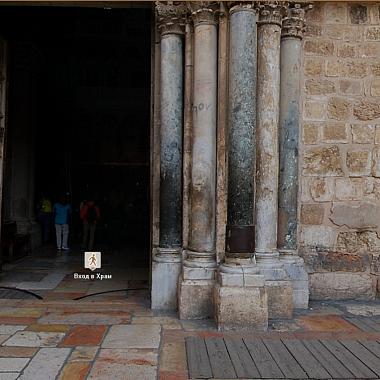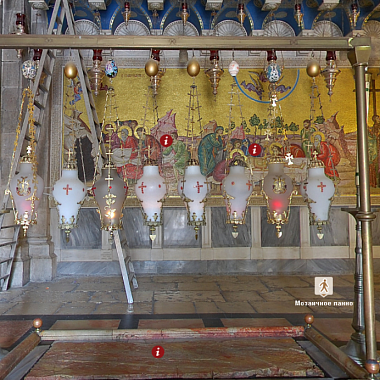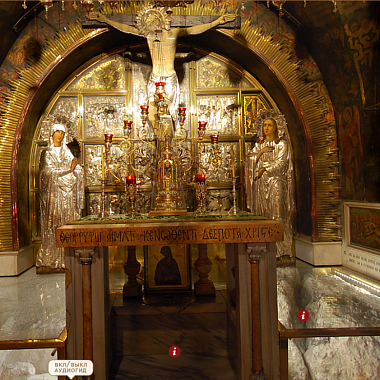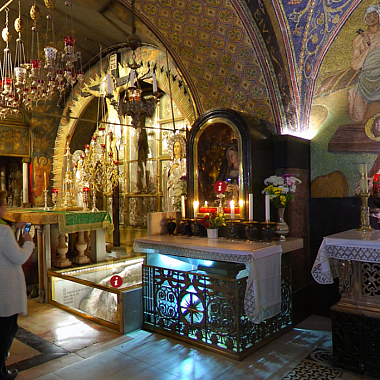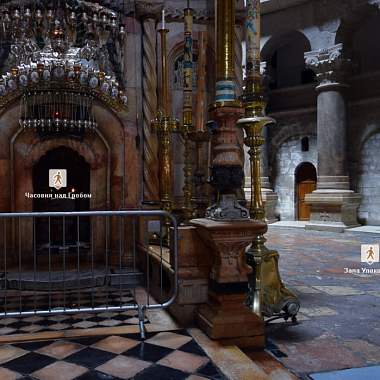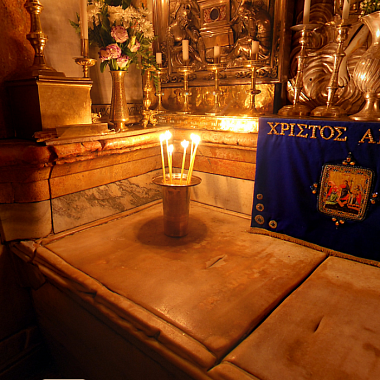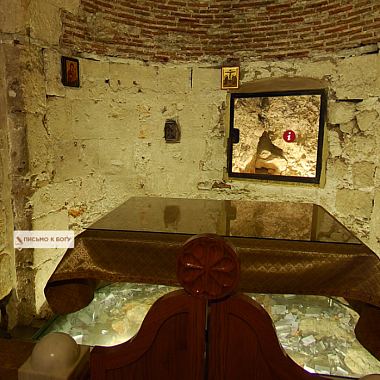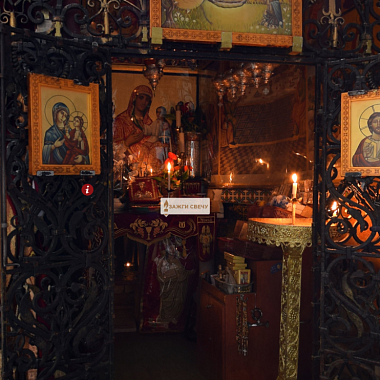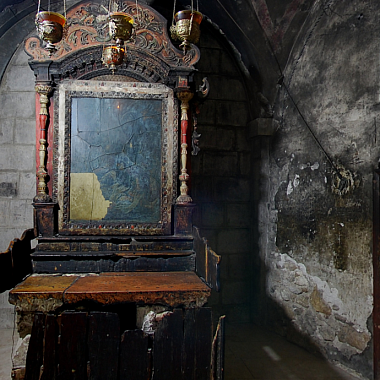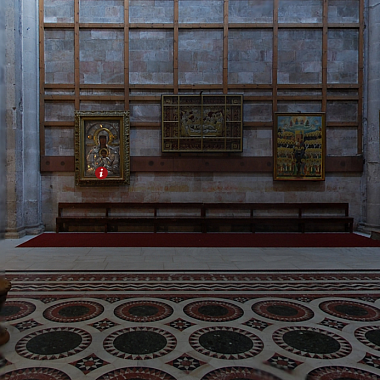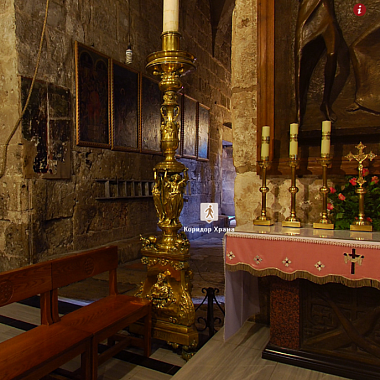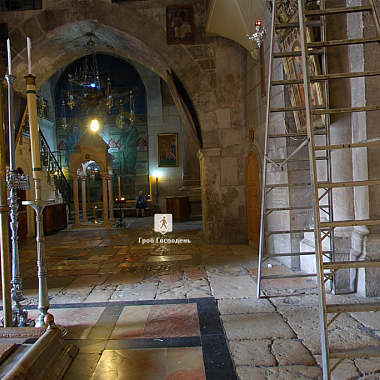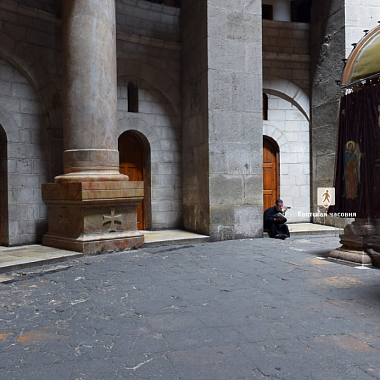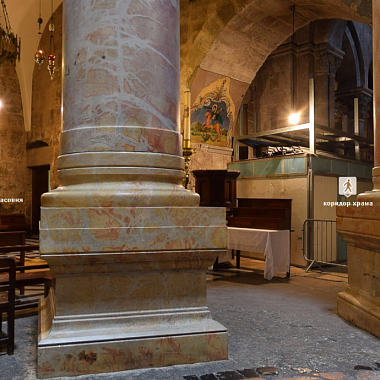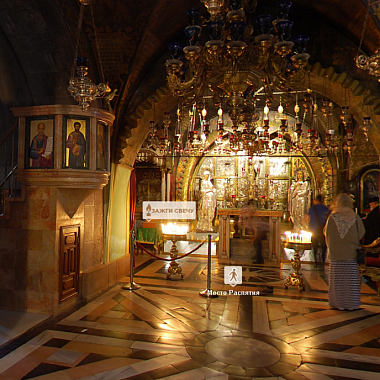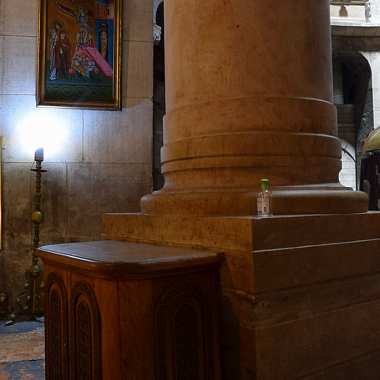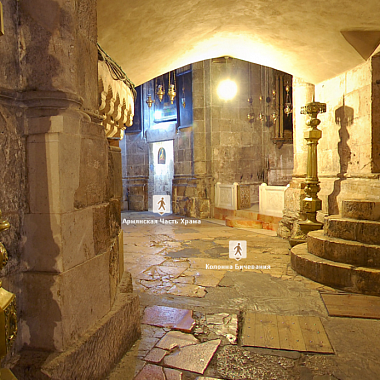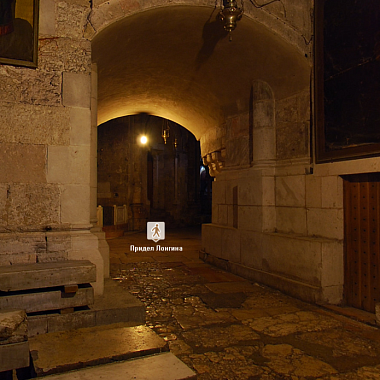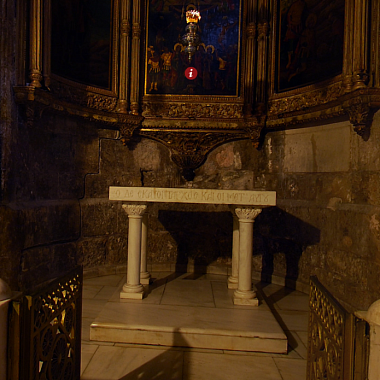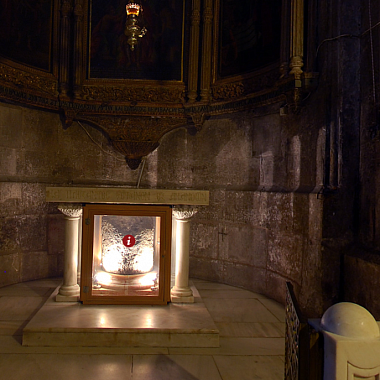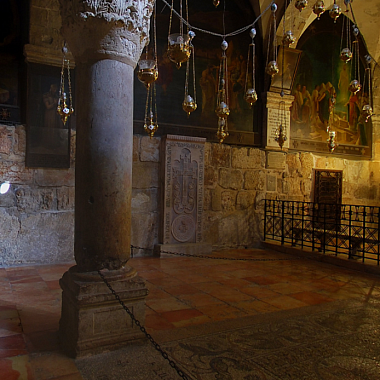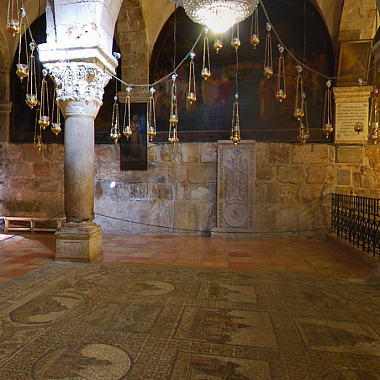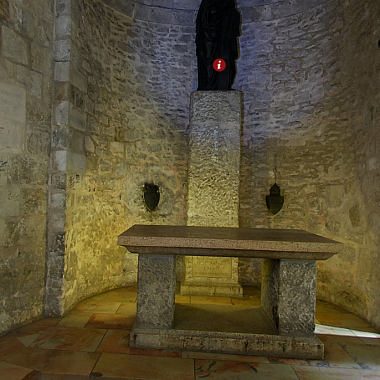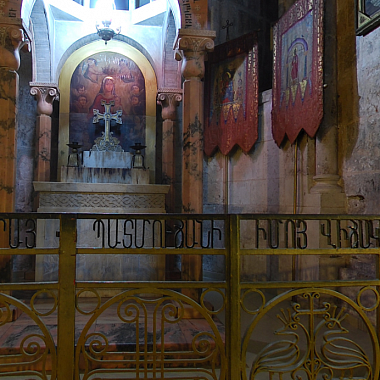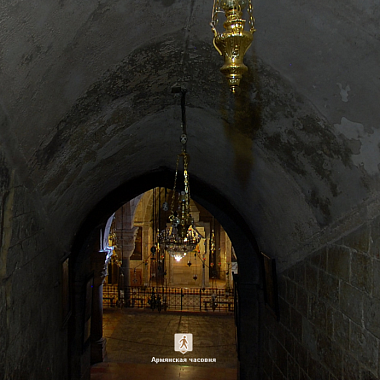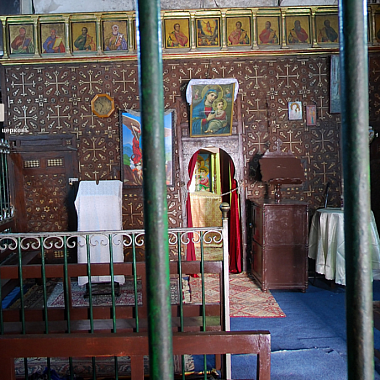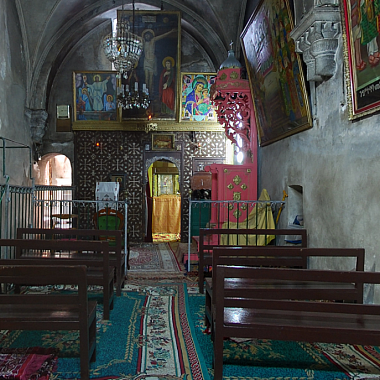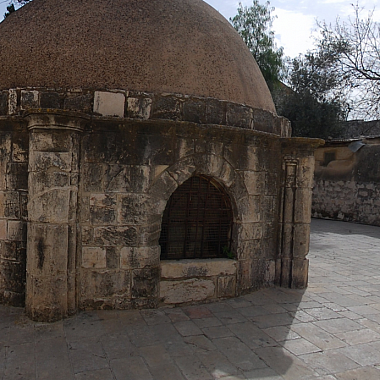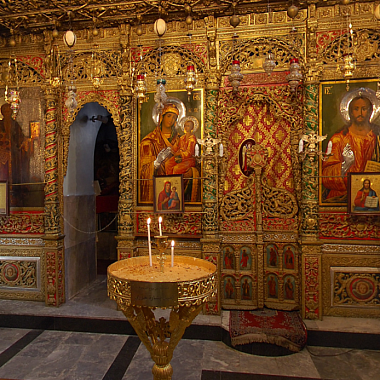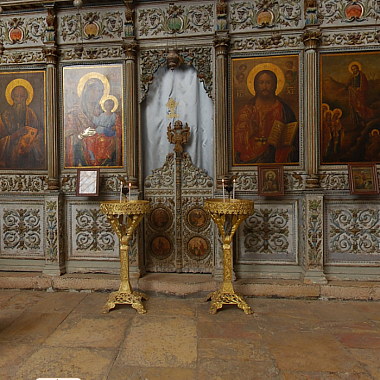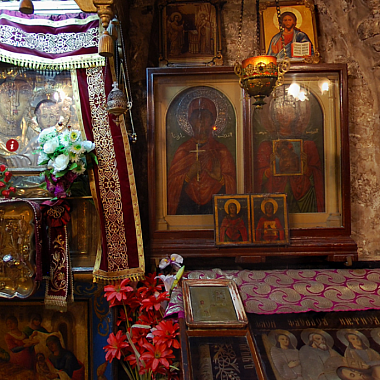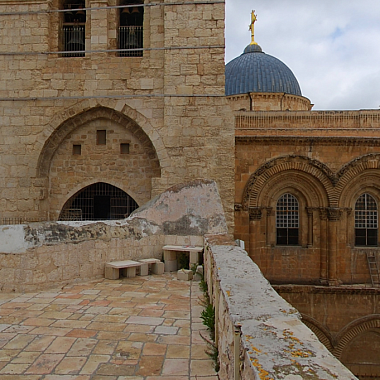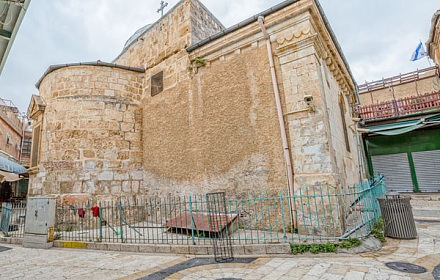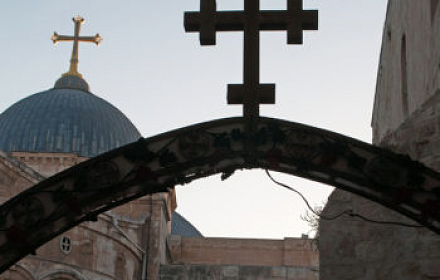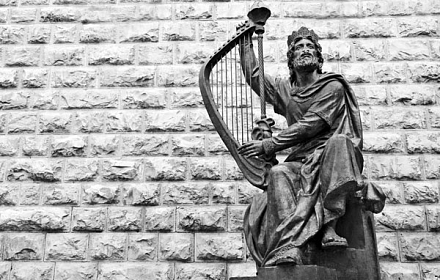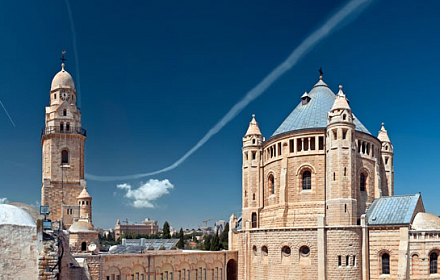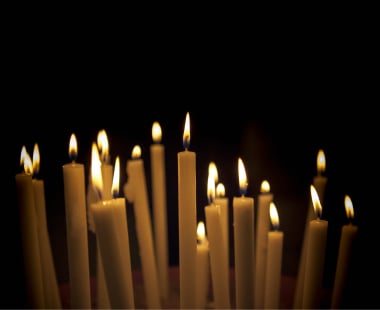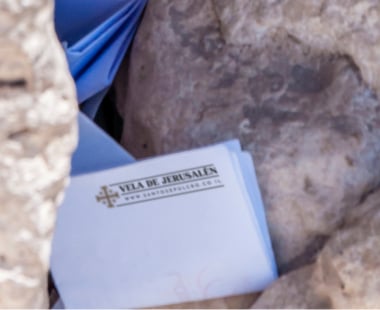About Virtual Tour
We are at the Temple of the Sepulcher and the Resurrection of the Lord, in that part of Jerusalem that two thousand years ago did not know either this Temple or any other building. For there was no city here, but there was Mount Golgotha - the place of execution of criminals and a cemetery - the world of dead people, whom the harsh people of that time always settled outside the city, away from the world of the living.
It was here, at this place, on Mount Calvary, that the Savior was martyred, and it was here that one of the members of the highest legislative and judicial assembly of Jerusalem, the rich and influential Joseph of Arimathea, being a secret worshiper of Christ, obtained permission from the Roman governor Pontius Pilate to bury the body Gentlemen, right after his death, on Friday. Let's go on a virtual pilgrimage.
And we see the Church of the Holy Sepulcher and the Resurrection of the Lord, built by descendants on this holy place for all Christians.
At the very beginning of the construction of the Temple, Golgotha was not covered with a roof, but over the Tomb of the Lord, over the place where Christ was resurrected, there was a round building, in architecture called the "Rotunda"
In the 12th century, during the era of the Crusaders, a large building was carried out, connecting under one roof - the Holy Sepulcher and Golgotha. The barred window to the right of the Entrance to the Temple indicates to us the level of the top of Golgotha.
To the left and right of the entrance to the Temple, you see the symmetrically placed columns of the Crusader era. Pay particular attention to the middle column to the left of the entrance. It has a deep crack - the result of a miracle that happened here in 1579, when, at the behest of the Turkish authorities, on Easter Saturday, on the day of the descent of the Holy Fire, the Jerusalem Patriarch and the entire Orthodox community were not allowed into the Temple. And people prayed to God, standing here in the courtyard of the Temple. And suddenly, thunder rumbled and lightning turned unprecedentedly bright, and it hit the column, and the column caught fire. This is how the Holy Fire came down this year, and a 120 cm long crack remained on the column, resembling a tongue of flame.
Since then, Orthodox people, like the rest of Christians, have been putting letters of prayers to God in this crack.
Under the crusaders there were two entrances to the Temple of the Sepulcher - one led directly to Golgotha; it was repaired under the Seljuq Turks in the 16th century. Let's go to the shrine, friends.
Blood and water flowed from this crack, which wetted Adam's head and washed away the sins of men. From now on, the crack is called an honest omen.
The chapel of Adam also houses a throne dedicated to Melchizedek, the legendary founder of Jerusalem.
According to the New Testament, Melchizedek was very famous. He had no earthly father, no mother, no ancestors, his life has no beginning or end; being like the Son of God, he remains a priest forever.
The Chapel of Adam - a place that combines the redemptive purity of Jesus and the power of inhuman wisdom of the unique knowledge of the ancient sciences and cults of Melchizedek - is unique for the imposition of written requests
Here we see four niches carved into the rock. These are ancient tombs for burying bones. It is here that the burial place of Joseph of Arimathea is located, who after his death bequeathed to bury him next to the Holy Sepulcher
In those distant times, burials were made in three stages.
At the first stage, the body was laid on a bed in a burial cave and covered with a stone. Exactly one year later, when only bones remained from the mortal body, the relatives of the deceased came and washed the bones, removing the remains of the flesh. During the stage of washing the bones, they always remembered the life and deeds of the deceased. Hence, by the way, the expression "wash the bones" has gone.
And finally, at the third, final stage of burial, the washed bones were placed in a separate niche for eternal storage, next to the bones of numerous ancestors.
A prominent place in the border of St. Joseph is occupied by the Altar in honor of the Most Holy Theotokos.
The icon is very poorly visible, because it was badly damaged by a fire that happened in the Temple 208 years ago, in 1808.
Every Sunday, services of representatives of the Syrian-Jacobite Orthodox denomination are held in this chapel. Unfortunately, the Syrians - Jacobites have no money for repairs.
If you leave the Kuvuklia, then on the left you will see the Catholic Altar of the Appearance of Christ to Mary Magdalene. In biblical times, there was the courtyard of Joseph of Arimathea, where Mary Magdalene grieved.
It was at this place that Mary Magdalene met the risen Christ.
As the Gospel of John says: “Jesus says to her: do not touch in Me, for I have not yet ascended to My Father; but go to my brothers and tell them: I ascend to my Father and your Father, and to my God and your God. "
Therefore, the altar is sometimes called: "Do not touch me."
Apparently, therefore, in the upper part of the altar there is a stylized sculptural composition of the meeting of Christ with Mary Magdalene, and in the lower part of the altar there are crossed hands.
On the left side is the organ of the Catholic Church, and on the right are the doors to the Catholic chapels
You are standing on Calvary, on the balcony. Directly opposite you, face to face, are the Armenian side altars of the second and third floors, the so-called small Golgotha, where the Armenian patriarch serves.
Turning around, and going straight, we find ourselves in the Orthodox limit of Golgotha, which is called the limit of the Crucifixion, there under the glass is the real rock of Calvary, the place where the cross stood, on which Jesus was martyred.
At the Altar of Calvary, we see three candlesticks To put a candle on Calvary for the health of a loved one, for the repose of the soul of the deceased is the dream of every Christian, for there is no place for a candle better than a place cleared of the vanity of sinful suffering of the Son of God - Jesus Christ.
A wide passage leads from the anointing stone to the Tomb of Jesus
In front of the entrance to the staircase there is a limit in the form of a marble tent, in the center of it there is always an inextinguishable candle. This is the Chapel of the Fainting of the Virgin. Here the Holy Virgin stood at the time of the crucifixion of the Son of God, here she heard the words of Jesus, words of love and support. Here the heart of the Mother of God could not stand ...
Behind the chapel, a staircase leads us to Armenian churches. The Armenian Sacristy is located on the side of the steps. In the daytime, a small church shop works here, where pilgrims can buy crosses and icons, myrrh and oil from the lamps of the Holy Sepulcher, other religious artifacts, and at night here an Armenian priest dresses in sacred robes before the night service.
Opposite the Chapel of the loss of consciousness by the Mother of God is the Altar of the Myrrh-Bearing Wives, marking the place from where they heard the angelic speech: “He is not here. He is risen. "
Finally, we see the most ancient part of the Temple of the Lord - the Church of St. Constantine. It is circular in shape, covered with a beautifully painted dome and surrounded by columns. In the middle of the Ancient Church is the greatest shrine of all Christians - the Chapel of the Holy Sepulcher of Christ (Edikula or Kuvukliya) - the place of burial and resurrection of the Son of God
Roman centurion Guy Cassius Longinus, commanded a detachment of Jesus' executioners. It was his responsibility to make sure that the executed person was dead. And he pierced Jesus with a spear under the right rib and was convinced that Jesus was dead. During the execution of Christ, blood spattered into his eyes, and Cassius, who had suffered from cataracts until that moment, was healed.
Church tradition reports that, besides being in the guard at the Cross, he also guarded the Holy Sepulcher and witnessed the resurrection of Jesus Christ. After that, he and other soldiers believed in Christ and refused to testify that the body of Christ was stolen by his disciples. And the centurion Longinus began to propagate the true faith in Jesus among the soldiers and officers of the Roman army, for which he was convicted and executed by beheading
We see three icons with you, in the central composition - Jesus on the Cross and Longinus piercing his body with a spear, the composition on the left - Longinus preaching to the soldiers of the Roman army, and the composition on the right - the moment of Longinus' execution. Gaius Cassius is on his knees, and the executioner raised his sword over him to chop off his head. And here on this icon we see a woman who bent over the already severed head of Longinus.
It was like this - when the centurion Longinus was cut off his head, the executioners also kicked her and she rolled to the side of the road. Later, a blind Jerusalem widow passed in this place, lost her way, she stumbled upon the severed head of the Roman officer Longinus, took it in her arms and began to cry over her that the man had been killed and not even buried, and left to lie on the side of the road. And at that moment - she saw the light.
To this day, it is believed that prayers to the centurion Longinus help with eye diseases
Inside the throne, covered with a marble slab, under the glass, we see an illuminated, low stone.
In those harsh times, the times of numerous riots against the injustices of the world, so many death sentences were passed that the rulers could not allow death row prisoners to hang on crosses for three days, delaying the queue for their execution. Therefore, before being led to execution, the condemned were beaten with whips with lead tips, so that they could die faster (within one day) on the cross. Also, to speed up the process of dying on the cross, the Roman governor Pontius Pilate replaced tying the body to the cross with ropes, with nailing the limbs of the condemned to the cross with nails - thanks to this, the condemned died even faster from loss of blood.
Here we see three icons. On the right side - Pontius Pilate pronounced judgment on Jesus and washes his hands. In the central icon there is an image of Jesus scourging on a stone, around him are Roman legionnaires who beat him and laughingly put a crown of thorns on the divine brow. The left icon depicts Jesus going out on his last journey.
Gregory the Illuminator is a saint, Christian educator of Armenia, founder of the Armenian Church. Born in 238 or 239, died in 335. Descended from the Parthian royal dynasty of Arshakuni as the Armenian kings of that period.
According to legend, the father of Saint Gregory, Anak, bribed by the Iranian shah, killed the Armenian king Khosrov and for this he himself paid with his life; the whole family of Anak was exterminated, except for the youngest son, whom his nurse, a Christian, managed to take to her homeland, to Caesarea in Cappadocia (now the city of Kayseri in Turkey)
There the boy was baptized, received the name Gregory and was brought up in a Christian spirit. Having married, he soon separated from his wife; she went to a monastery, and Gregory went to Rome and there entered the service of Tiridates (286-342), the son of the deceased king Khosrov, wishing by diligent service to atone for the guilt of his father.
Gregory healed Tiridates, who fell into madness, and the grateful king believed in Christ in 305-306. proclaimed Christianity the state religion in Great Armenia.
Originally, the chapel, which today is dedicated to the acquisition of the cross, was built by Queen Helena herself, on the site of an ancient quarry where two more robbers were crucified on the day of Jesus' death.
Having discovered three crosses here, during archeological excavations, Empress Helena experimentally identified the true cross - the cross on which Jesus was crucified.
Tradition says that only the true cross worked miracles, healed the sick and raised the dead. And Queen Helen solemnly lifted up the true cross to the top of Mount Calvary and erected it there. And the masses of the people went to worship him.
The early pilgrims testify to the veneration of the place of finding the cross in their diaries, one of whom testifies: “From Golgotha to the place where the cross was found, fifty steps. ... we bowed to him and kissed him. I saw, held in my hands and kissed the writing that was above the head of the Lord, and where it is written: "This is the king of the Jews." It is a walnut cross tree. ”
Currently, the true cross has been taken apart in pieces, which are carefully preserved not only in the Chapel of Adam of the Church of the Holy Sepulcher, but also in many Christian churches around the world.
The Chapel of St. Helena has two parts - Orthodox, with the remains of ancient frescoes, now protected by glass, and Catholic - with a statue of St. Helena that has acquired a true cross.
The side-altar of Reese in the Church of the Holy Sepulcher symbolizes the removal of the holy garments from Jesus by the Roman soldiers. Before the crucifixion of the Lord, the Roman soldiers stripped him and divided his clothes into four parts
But, as the holy books say, Jesus was wearing a very nice shirt without seams, which the soldiers were afraid to tear, and so they decided to play it with dice.
It is believed that this shirt was sewn by his mother Maria. Because of this, you can often see Mary with a spindle in her hands on icons. Today, near this limit, the Armenian Church is conducting a service, but the very place where the holy clothes are divided is sacred for the entire Christian world.
According to the Biblical tradition, the queen of the land of Saba heard about the great wisdom of King Solomon and made a trip to him with rich gifts - spices, gold, precious stones. She also wanted to ask him some tricky riddles to test his wisdom. King Solomon and Queen of Sheba met. The queen was impressed by the wisdom of Solomon and his wealth, although she herself was far from poor: as a gift to Solomon, she brought four and a half tons of gold on 797 camels. The length of the path through the deserts of Arabia, along the shores of the Red Sea and the Jordan River to Jerusalem was about 700 kilometers. Since the queen traveled on camels, such a journey had to last about 6 months only one way. She also returned to her country with rich gifts from the ruler of Israel: the beauty of the queen from the southern country charmed Solomon.
Ancient Ethiopian legends say that King Solomon and Queen of Sheba had a son, Menelik, who became the first emperor of Ethiopia. Having fallen in love with the queen, according to ancient texts, he decided to act by cunning: he promised not to harass her if she vows not to take anything from him without asking, and ordered salted dishes to be served for dinner. At night, the queen, suffering from thirst, drank from a jug next to the bed. Solomon immediately accused her of stealing and forced her to love. Their romance lasted six months, but the memory of the relationship between Ethiopians and Israelis is still alive. The emperors of Ethiopia, from the Middle Ages to the fall of the monarchy in 1974, used the Jewish lion and the six-pointed star, reminiscent of the Star of David, as national symbols.
After the death and resurrection of Jesus, Saint James was the first leader of the Christian community of Christians in Jerusalem. 2,000 years ago there was a catacomb Christian church
Orthodox Arabs, the most ancient inhabitants of Jerusalem, serve in the Church of St. James. Along with religious artifacts, one can also see beautiful, very prayed icons of the Byzantine style, including three ancient images of the Virgin
Mary was born in Egypt in the middle of the 5th century and at the age of twelve left her parents, going to Alexandria, where she became a harlot. For more than seventeen years she indulged in this occupation. Once Mary, seeing a group of pilgrims heading to Jerusalem for the Feast of the Exaltation of the Cross of the Lord, she joined them, but not with pious thoughts, but "so that there was more to indulge in debauchery with." In Jerusalem, Mary tried to enter the Church of the Holy Sepulcher, but some kind of force held her back. Realizing her fall, she began to pray in front of the icon of the Mother of God, which was located here in the narthex of the temple. After that, she was able to enter the temple and worship the Life-giving Cross. Coming out, Mary again turned with a prayer of thanks to the Virgin Mary and heard a voice saying to her - "If you cross over the Jordan, you will find blessed peace."
After listening to this command, Mary took the sacrament and, crossing the Jordan, settled in the desert, where she spent 47 years in complete solitude, fasting and prayers of repentance. For the first 17 years, Mary was haunted by prodigal passions and memories of her past life:
When I ate, I dreamed of the meat and wine I ate in Egypt; I wanted to drink my favorite wine. When I was in the world, I drank a lot of wine, but here I had no water; I was thirsty and terribly tormented. Sometimes I had a very embarrassing desire to sing the prodigal songs to which I was used. Then I shed tears, beat myself on the chest and remembered the vows I made when leaving for the desert.
After these many years of temptation, the passions left her, the food taken from Jerusalem ran out, and the clothes decayed from dilapidation, but, as her life tells us, "from that time ... the power of God in everything transformed my sinful soul and my humble body."
The Christian faith views the example of Mary of Egypt as an example of perfect repentance. It is believed that through prayers to the Monk Mary, believers can get rid of lustful passion.
Nowadays, Mary of Egypt is considered the patroness of penitent women
In the Gospel of John, Mary Magdalene is the first to see the resurrected Christ: "Mary stood at the tomb and wept. And when she was crying, she leaned into the tomb and sees two Angels sitting in a white robe, one at the head and the other at the feet, where the body of Jesus lay And they said to her: Wife, why are you crying? He said to them, They have taken away my Lord, and I do not know where they have laid Him. Having said this, she turned back and saw Jesus standing, but did not know that it was Jesus. Jesus said to her: Wife Why are you crying? Whom are you looking for? She, thinking that this is a gardener, says to Him: Sir, if you have carried Him out, tell me where you put Him, and I will take Him. Jesus says to her: Mary! To him: Rabboni! - which means: Teacher! Jesus says to her: do not touch Me, for I have not yet ascended to My Father; but go to My brothers and tell them: I am ascending to My Father and your Father, and to My God and To your God. "
In the Western tradition, the plot of the meeting of the resurrected Savior and Mary Magdalene was called "Noli me tangere", this is how the Latin phrase of Christ "Do not touch me" addressed to Magdalene sounds.
And it was here.
The limit of myrrh-bearing wives. Dedicated to women who came to the Holy Sepulcher on the morning of the first day after Saturday, with fragrances and incense (peace) for ritual anointing of the body. Women, going to the tomb, reasoned, "who will roll the stone from the tomb." Before their arrival, due to the descent of the Angel, an earthquake occurred, which rolled off a stone and plunged the guards into fear. According to legend, it was here that an Angel descended from heaven told the women that Christ had risen
The Stone of Anointing.
The Stone of Anointing. It was on him, the secret disciple of Christ, the head of the Jerusalem community, Joseph of Arifomea with his relative Nicodemus, they laid the body of the Lord, carefully removed from the Cross, it was on it, they washed the blood from the wounds of Jesus, anointed Him with myrrh (holy liquid protecting not only the body but and the human soul from wounds, sins and temptations) and wrapped the divine body in a shroud. Every morning, the servants of the Temple irrigate the Holy Stone with peace. They do this so that believing pilgrims, by attaching things dear to their hearts to the stone (scarves, crosses, photographs of relatives, other objects), can take with them the grace of the heart of the Lord and bring it to their home. In the Christian tradition, the attributes of religion assigned to the Anointing Stone are considered sanctified. After such consecration, the pilgrims took the icon or crosses to their homes or gave them to friends. It is believed that such a consecrated object in the house ensures the presence of God, His patronage and protection. The power of the Anointing Stone was recognized even by Muslim rulers, who for more than 10 centuries were the full masters of these lands. Whatever the conflicts between Muslims and Christians, the Anointing Stone remained inviolable for everyone. Even the most formidable warriors did not dare to forbid Christian pilgrims to consecrate things on the Stone of Confirmation. Place of the crucifixion of Jesus Christ. Under the glass you can see the true rock of Golgotha at the place where the cross stood. It is here that every pilgrim, kneeling down, can kiss the true rock of Calvary. Above Calvary, you and I see a Greek icon telling us that Jesus is the bridegroom of the Church who loves the Church with eternal love. To the right of the crucifix, on the Catholic part of the Reach, there is a very expressive sculpture of the grieving Madonna, with a dagger in her heart, personifying the grief of the mother of God. A present from the Portuguese king. The sword pierces the heart of the Holy Mother of God, symbolizing the prophetic words of Simeon the God-Receiver: "And the weapon will pass through the soul to You, - may the thoughts of many hearts be revealed." (Luke 2: 34-35). The border between the Orthodox and Catholic limits is easy to see. To do this, you need to look at the floor - the red floor is the Orthodox limit, the white is Catholic. Calvary is the right place for lighting candles. We see a small Catholic altar "Stabat Mater" - the Standing of the Mother of God, located between the altars of the Crucifixion and the Nails. It marks the place where, according to legend, the Mother of God stood at the Crucifixion of the Son at the base of the Cross. Above the altar stands a statue of Our Lady carved out of wood, donated in 1778 by the Queen of Portugal and brought from Lisbon. Nearby you can see many jewels donated by pilgrims. The throne, separated by a silver bas-relief, is a gift from the famous rulers of Italian Florence, the Medici family, made in the 16th century Mosaic panel Stabat Mater - Mother standing over the dead body of her son. The woman who fell to the body of the Lord is Mary Magdalene. The Chapel of the Holy Sepulcher is located in the center of the Rotunda, and above it you can see a beautiful dome built according to the plan of an Armenian architect. The Holy Sepulcher is the main altar of the Church of the Resurrection of Christ. Regular Christian services at the Holy Sepulcher began in 335 at the latest and continue to the present. Today, only Orthodox Christians, Armenians and Catholics have the right to alternately serve here, since it is these confessions that jointly own the Holy Sepulcher. Three Liturgies are celebrated daily on the Holy Sepulcher. The Orthodox are the first to serve the liturgy, at midnight, they have the right to celebrate the service from 11 pm to 3 am. The Armenians serve liturgy for the Greeks, from 3 to 6 in the morning. Catholic Liturgy is celebrated from 6 to 9 am The vestibule of the chapel has large and small lamps on each side. On the facade you can see icons with hanging lamps depicting the Resurrection of JesusThe Chapel of Adam
The Chapel of Adam is located exactly under the altar of the Orthodox Calvary. A cleft is especially clearly visible here, which is visible at the top, to the right of the altar. According to legend, it was here, under the future Crucifixion, that the First Man Adam was buried, and when the blood of Jesus Christ spilled on the rock after being hit with a spear by the centurion Longinus, the rock under the blood that fell on it cracked to its full depth.Blood and water flowed from this crack, which wetted Adam's head and washed away the sins of men. From now on, the crack is called an honest omen.
The chapel of Adam also houses a throne dedicated to Melchizedek, the legendary founder of Jerusalem.
According to the New Testament, Melchizedek was very famous. He had no earthly father, no mother, no ancestors, his life has no beginning or end; being like the Son of God, he remains a priest forever.
The Chapel of Adam - a place that combines the redemptive purity of Jesus and the power of inhuman wisdom of the unique knowledge of the ancient sciences and cults of Melchizedek - is unique for the imposition of written requests
Here we see four niches carved into the rock. These are ancient tombs for burying bones. It is here that the burial place of Joseph of Arimathea is located, who after his death bequeathed to bury him next to the Holy Sepulcher
In those distant times, burials were made in three stages.
At the first stage, the body was laid on a bed in a burial cave and covered with a stone. Exactly one year later, when only bones remained from the mortal body, the relatives of the deceased came and washed the bones, removing the remains of the flesh. During the stage of washing the bones, they always remembered the life and deeds of the deceased. Hence, by the way, the expression "wash the bones" has gone.
And finally, at the third, final stage of burial, the washed bones were placed in a separate niche for eternal storage, next to the bones of numerous ancestors.
A prominent place in the border of St. Joseph is occupied by the Altar in honor of the Most Holy Theotokos.
The icon is very poorly visible, because it was badly damaged by a fire that happened in the Temple 208 years ago, in 1808.
Every Sunday, services of representatives of the Syrian-Jacobite Orthodox denomination are held in this chapel. Unfortunately, the Syrians - Jacobites have no money for repairs.
If you leave the Kuvuklia, then on the left you will see the Catholic Altar of the Appearance of Christ to Mary Magdalene. In biblical times, there was the courtyard of Joseph of Arimathea, where Mary Magdalene grieved.
It was at this place that Mary Magdalene met the risen Christ.
As the Gospel of John says: “Jesus says to her: do not touch in Me, for I have not yet ascended to My Father; but go to my brothers and tell them: I ascend to my Father and your Father, and to my God and your God. "
Therefore, the altar is sometimes called: "Do not touch me."
Apparently, therefore, in the upper part of the altar there is a stylized sculptural composition of the meeting of Christ with Mary Magdalene, and in the lower part of the altar there are crossed hands.
On the left side is the organ of the Catholic Church, and on the right are the doors to the Catholic chapels
You are standing on Calvary, on the balcony. Directly opposite you, face to face, are the Armenian side altars of the second and third floors, the so-called small Golgotha, where the Armenian patriarch serves.
Turning around, and going straight, we find ourselves in the Orthodox limit of Golgotha, which is called the limit of the Crucifixion, there under the glass is the real rock of Calvary, the place where the cross stood, on which Jesus was martyred.
At the Altar of Calvary, we see three candlesticks To put a candle on Calvary for the health of a loved one, for the repose of the soul of the deceased is the dream of every Christian, for there is no place for a candle better than a place cleared of the vanity of sinful suffering of the Son of God - Jesus Christ.
A wide passage leads from the anointing stone to the Tomb of Jesus
In front of the entrance to the staircase there is a limit in the form of a marble tent, in the center of it there is always an inextinguishable candle. This is the Chapel of the Fainting of the Virgin. Here the Holy Virgin stood at the time of the crucifixion of the Son of God, here she heard the words of Jesus, words of love and support. Here the heart of the Mother of God could not stand ...
Behind the chapel, a staircase leads us to Armenian churches. The Armenian Sacristy is located on the side of the steps. In the daytime, a small church shop works here, where pilgrims can buy crosses and icons, myrrh and oil from the lamps of the Holy Sepulcher, other religious artifacts, and at night here an Armenian priest dresses in sacred robes before the night service.
Opposite the Chapel of the loss of consciousness by the Mother of God is the Altar of the Myrrh-Bearing Wives, marking the place from where they heard the angelic speech: “He is not here. He is risen. "
Finally, we see the most ancient part of the Temple of the Lord - the Church of St. Constantine. It is circular in shape, covered with a beautifully painted dome and surrounded by columns. In the middle of the Ancient Church is the greatest shrine of all Christians - the Chapel of the Holy Sepulcher of Christ (Edikula or Kuvukliya) - the place of burial and resurrection of the Son of God
Roman centurion Guy Cassius Longinus, commanded a detachment of Jesus' executioners. It was his responsibility to make sure that the executed person was dead. And he pierced Jesus with a spear under the right rib and was convinced that Jesus was dead. During the execution of Christ, blood spattered into his eyes, and Cassius, who had suffered from cataracts until that moment, was healed.
Church tradition reports that, besides being in the guard at the Cross, he also guarded the Holy Sepulcher and witnessed the resurrection of Jesus Christ. After that, he and other soldiers believed in Christ and refused to testify that the body of Christ was stolen by his disciples. And the centurion Longinus began to propagate the true faith in Jesus among the soldiers and officers of the Roman army, for which he was convicted and executed by beheading
We see three icons with you, in the central composition - Jesus on the Cross and Longinus piercing his body with a spear, the composition on the left - Longinus preaching to the soldiers of the Roman army, and the composition on the right - the moment of Longinus' execution. Gaius Cassius is on his knees, and the executioner raised his sword over him to chop off his head. And here on this icon we see a woman who bent over the already severed head of Longinus.
It was like this - when the centurion Longinus was cut off his head, the executioners also kicked her and she rolled to the side of the road. Later, a blind Jerusalem widow passed in this place, lost her way, she stumbled upon the severed head of the Roman officer Longinus, took it in her arms and began to cry over her that the man had been killed and not even buried, and left to lie on the side of the road. And at that moment - she saw the light.
To this day, it is believed that prayers to the centurion Longinus help with eye diseases
Inside the throne, covered with a marble slab, under the glass, we see an illuminated, low stone.
In those harsh times, the times of numerous riots against the injustices of the world, so many death sentences were passed that the rulers could not allow death row prisoners to hang on crosses for three days, delaying the queue for their execution. Therefore, before being led to execution, the condemned were beaten with whips with lead tips, so that they could die faster (within one day) on the cross. Also, to speed up the process of dying on the cross, the Roman governor Pontius Pilate replaced tying the body to the cross with ropes, with nailing the limbs of the condemned to the cross with nails - thanks to this, the condemned died even faster from loss of blood.
Here we see three icons. On the right side - Pontius Pilate pronounced judgment on Jesus and washes his hands. In the central icon there is an image of Jesus scourging on a stone, around him are Roman legionnaires who beat him and laughingly put a crown of thorns on the divine brow. The left icon depicts Jesus going out on his last journey.
Gregory the Illuminator is a saint, Christian educator of Armenia, founder of the Armenian Church. Born in 238 or 239, died in 335. Descended from the Parthian royal dynasty of Arshakuni as the Armenian kings of that period.
According to legend, the father of Saint Gregory, Anak, bribed by the Iranian shah, killed the Armenian king Khosrov and for this he himself paid with his life; the whole family of Anak was exterminated, except for the youngest son, whom his nurse, a Christian, managed to take to her homeland, to Caesarea in Cappadocia (now the city of Kayseri in Turkey)
There the boy was baptized, received the name Gregory and was brought up in a Christian spirit. Having married, he soon separated from his wife; she went to a monastery, and Gregory went to Rome and there entered the service of Tiridates (286-342), the son of the deceased king Khosrov, wishing by diligent service to atone for the guilt of his father.
Gregory healed Tiridates, who fell into madness, and the grateful king believed in Christ in 305-306. proclaimed Christianity the state religion in Great Armenia.
Originally, the chapel, which today is dedicated to the acquisition of the cross, was built by Queen Helena herself, on the site of an ancient quarry where two more robbers were crucified on the day of Jesus' death.
Having discovered three crosses here, during archeological excavations, Empress Helena experimentally identified the true cross - the cross on which Jesus was crucified.
Tradition says that only the true cross worked miracles, healed the sick and raised the dead. And Queen Helen solemnly lifted up the true cross to the top of Mount Calvary and erected it there. And the masses of the people went to worship him.
The early pilgrims testify to the veneration of the place of finding the cross in their diaries, one of whom testifies: “From Golgotha to the place where the cross was found, fifty steps. ... we bowed to him and kissed him. I saw, held in my hands and kissed the writing that was above the head of the Lord, and where it is written: "This is the king of the Jews." It is a walnut cross tree. ”
Currently, the true cross has been taken apart in pieces, which are carefully preserved not only in the Chapel of Adam of the Church of the Holy Sepulcher, but also in many Christian churches around the world.
The Chapel of St. Helena has two parts - Orthodox, with the remains of ancient frescoes, now protected by glass, and Catholic - with a statue of St. Helena that has acquired a true cross.
The side-altar of Reese in the Church of the Holy Sepulcher symbolizes the removal of the holy garments from Jesus by the Roman soldiers. Before the crucifixion of the Lord, the Roman soldiers stripped him and divided his clothes into four parts
But, as the holy books say, Jesus was wearing a very nice shirt without seams, which the soldiers were afraid to tear, and so they decided to play it with dice.
It is believed that this shirt was sewn by his mother Maria. Because of this, you can often see Mary with a spindle in her hands on icons. Today, near this limit, the Armenian Church is conducting a service, but the very place where the holy clothes are divided is sacred for the entire Christian world.
According to the Biblical tradition, the queen of the land of Saba heard about the great wisdom of King Solomon and made a trip to him with rich gifts - spices, gold, precious stones. She also wanted to ask him some tricky riddles to test his wisdom. King Solomon and Queen of Sheba met. The queen was impressed by the wisdom of Solomon and his wealth, although she herself was far from poor: as a gift to Solomon, she brought four and a half tons of gold on 797 camels. The length of the path through the deserts of Arabia, along the shores of the Red Sea and the Jordan River to Jerusalem was about 700 kilometers. Since the queen traveled on camels, such a journey had to last about 6 months only one way. She also returned to her country with rich gifts from the ruler of Israel: the beauty of the queen from the southern country charmed Solomon.
Ancient Ethiopian legends say that King Solomon and Queen of Sheba had a son, Menelik, who became the first emperor of Ethiopia. Having fallen in love with the queen, according to ancient texts, he decided to act by cunning: he promised not to harass her if she vows not to take anything from him without asking, and ordered salted dishes to be served for dinner. At night, the queen, suffering from thirst, drank from a jug next to the bed. Solomon immediately accused her of stealing and forced her to love. Their romance lasted six months, but the memory of the relationship between Ethiopians and Israelis is still alive. The emperors of Ethiopia, from the Middle Ages to the fall of the monarchy in 1974, used the Jewish lion and the six-pointed star, reminiscent of the Star of David, as national symbols.
After the death and resurrection of Jesus, Saint James was the first leader of the Christian community of Christians in Jerusalem. 2,000 years ago there was a catacomb Christian church
Orthodox Arabs, the most ancient inhabitants of Jerusalem, serve in the Church of St. James. Along with religious artifacts, one can also see beautiful, very prayed icons of the Byzantine style, including three ancient images of the Virgin
Mary was born in Egypt in the middle of the 5th century and at the age of twelve left her parents, going to Alexandria, where she became a harlot. For more than seventeen years she indulged in this occupation. Once Mary, seeing a group of pilgrims heading to Jerusalem for the Feast of the Exaltation of the Cross of the Lord, she joined them, but not with pious thoughts, but "so that there was more to indulge in debauchery with." In Jerusalem, Mary tried to enter the Church of the Holy Sepulcher, but some kind of force held her back. Realizing her fall, she began to pray in front of the icon of the Mother of God, which was located here in the narthex of the temple. After that, she was able to enter the temple and worship the Life-giving Cross. Coming out, Mary again turned with a prayer of thanks to the Virgin Mary and heard a voice saying to her - "If you cross over the Jordan, you will find blessed peace."
After listening to this command, Mary took the sacrament and, crossing the Jordan, settled in the desert, where she spent 47 years in complete solitude, fasting and prayers of repentance. For the first 17 years, Mary was haunted by prodigal passions and memories of her past life:
When I ate, I dreamed of the meat and wine I ate in Egypt; I wanted to drink my favorite wine. When I was in the world, I drank a lot of wine, but here I had no water; I was thirsty and terribly tormented. Sometimes I had a very embarrassing desire to sing the prodigal songs to which I was used. Then I shed tears, beat myself on the chest and remembered the vows I made when leaving for the desert.
After these many years of temptation, the passions left her, the food taken from Jerusalem ran out, and the clothes decayed from dilapidation, but, as her life tells us, "from that time ... the power of God in everything transformed my sinful soul and my humble body."
The Christian faith views the example of Mary of Egypt as an example of perfect repentance. It is believed that through prayers to the Monk Mary, believers can get rid of lustful passion.
Nowadays, Mary of Egypt is considered the patroness of penitent women
In the Gospel of John, Mary Magdalene is the first to see the resurrected Christ: "Mary stood at the tomb and wept. And when she was crying, she leaned into the tomb and sees two Angels sitting in a white robe, one at the head and the other at the feet, where the body of Jesus lay And they said to her: Wife, why are you crying? He said to them, They have taken away my Lord, and I do not know where they have laid Him. Having said this, she turned back and saw Jesus standing, but did not know that it was Jesus. Jesus said to her: Wife Why are you crying? Whom are you looking for? She, thinking that this is a gardener, says to Him: Sir, if you have carried Him out, tell me where you put Him, and I will take Him. Jesus says to her: Mary! To him: Rabboni! - which means: Teacher! Jesus says to her: do not touch Me, for I have not yet ascended to My Father; but go to My brothers and tell them: I am ascending to My Father and your Father, and to My God and To your God. "
In the Western tradition, the plot of the meeting of the resurrected Savior and Mary Magdalene was called "Noli me tangere", this is how the Latin phrase of Christ "Do not touch me" addressed to Magdalene sounds.
And it was here.
The limit of myrrh-bearing wives. Dedicated to women who came to the Holy Sepulcher on the morning of the first day after Saturday, with fragrances and incense (peace) for ritual anointing of the body. Women, going to the tomb, reasoned, "who will roll the stone from the tomb." Before their arrival, due to the descent of the Angel, an earthquake occurred, which rolled off a stone and plunged the guards into fear. According to legend, it was here that an Angel descended from heaven told the women that Christ had risen
Send donation
If you are in a difficult financial situation, we will light the candle for free. For that purpose email us at coordinator@santosepulcro.co.il
Payment Methods
